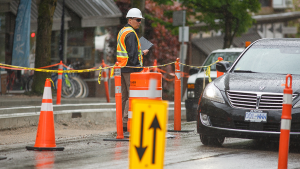Professor Janaka Ruwanpura, Ph.D, P.Eng and PQS led a seminar at the VRCA Construction Learning Forum, held May 25th in Whistler entitled "Top Ten Targets for Improving Construction Productivity."
Professor Janaka Ruwanpura, Ph.D, P.Eng and PQS led a seminar at the VRCA Construction Learning Forum, held May 25th in Whistler entitled "Top Ten Targets for Improving Construction Productivity."
Ruwanpura is the director of the Centre for Project Management Excellence at the University of Calgary, which works with many different research partner companies and organizations.
The centre started a multi-phase productivity research program in 2004, which develops and tests best work practices and tools to improve the construction industry.
The program is broken down into four phase, and involves 14 research partners including the Natural Sciences and Engineering Research Council, and has trained over 4,000 participants.
Productivity is affected by many issues, but it boils down to Productivity = Output divided by Work Hours, Ruwanpura said. ..dSome of the issues affecting productivity include technical, management, and human/labour issues. External factors (such as, in the case of construction, weather) and market conditions also affect productivity, and are difficult if not impossible to control.
Productivity Losses Indicators include excess time spent on tasks and underutilized time such as a skilled worker involved in unskilled work. Idle time that is process driven, no value added time, and unplanned and accidental time all lead to production loss, as do wait times, and unaccounted time such as lateness or breaks.
Targets for improving construction productivity include an efficient working relationships model, communication and technology, better integration between the site and the office, a highly motivated and specialized work force, a best practices model for supervision, “sticking to plan”, and material/tools management. Ruwanpura said the outcome of these ten areas is a productivity toolbox.
Computerized site layout planning allows a plan to be created from start to end to minimize breakage and disruption, and can be linked to all subcontractors.
Developing performance evaluation criteria for rewarding construction workers based on performance improves productivity, Ruwanpura said.
One of the major projects of Ruwanpura’s program is the i-booth, an information kiosk built to enhance information management and communication on construction sites.
The i-booth integrates information between office and site, and facilitates on-site communication between different project personnel and construction workers. It is also a multi-touch display which uses the latest advancements in distributed data warehousing and security technologies.
When testing the i-booth prototypes, tool time, communication and productivity improved substantially.
Introducing cameras to job sites for “virtual supervision” has generated zero complaints, Ruwanpura said, and productivity went up. Workers don’t remember a camera is present after a while, he said.
The i-booth not only calls up plans and enhances communication but can also call up safety videos and keep quality control checklists. BIM documents can also be browsed through on the system. Regulations and permits can also be called up, as can work packages.
Future iterations will be able to track workers by hard hat through computerized pattern recognition, which means tool time and time spent in a location can now be tracked.
JOC DIGITAL MEDIA










Recent Comments
comments for this post are closed